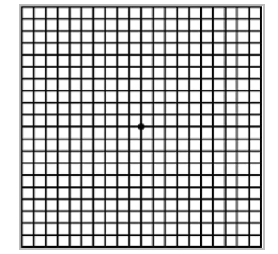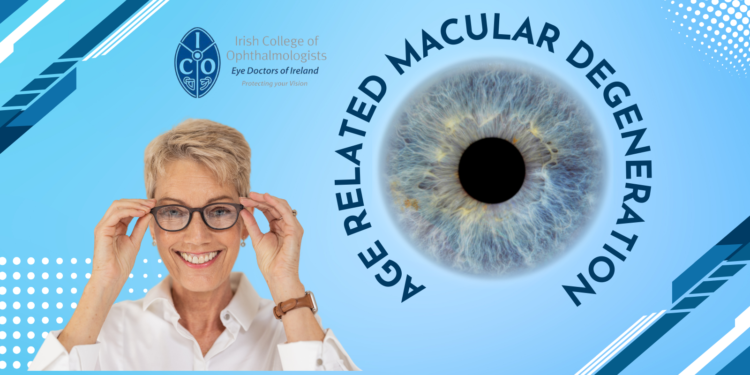Age related macular degeneration (AMD) is the leading cause of sight loss in the over 50s in Ireland. More than 100,000 people in Ireland aged over 50 are living with AMD. Its prognosis has been greatly improved with modern treatment modalities. Without treatment, severe (wet) AMD can lead to loss of central vision and it is the most common cause of legal blindness in the over 60s.
The severity of the disease varies between individuals. Early detection is critical. Usually, even in its most aggressive form, side or peripheral vision is preserved allowing the patient to move around independently and to continue those tasks that do not require fine central vision.
Early diagnosis and treatment by an ophthalmologist is recommended which results in a better visual outcome for patients.
What is AMD?

Age related macular degeneration is an ageing change in the macula. The macula is the central part of the light sensitive retina. The retina lines the inside of the back of the eye and is responsible for vision. Light focused on the retina is transformed to an electrical signal that is sent to the brain where ‘seeing’ takes place. The macula is responsible for central and fine vision such as reading, colour vision and recognising facial details.
AMD affects the central vision, where the sharpest vision occurs, and can cause difficulty undertaking daily tasks such as reading, driving and recognising faces.
What causes AMD?
Risk factors for AMD include age, genetic predisposition, dietary and environmental factors such as smoking and cardiovascular disease. Ultraviolet exposure may also have a role. The greatest risk factor is age: a person’s risk typically begins to escalate after age 50. Studies show that after age 75, AMD affects nearly 40 percent of seniors. Smoking poses a significant risk for AMD especially in women.
There are two main types of AMD, ‘Dry’ (atrophic) and ‘Wet’ (neovascular) AMD. Wet AMD represents an advanced stage of the disease. It is almost always preceded by Dry AMD.
Dry AMD
Dry AMD is the most common (80-90%) and the mildest form of the condition. In this type, there are typical age changes such as age spots or ‘Drusen ‘ in the macula. Very often patients with Dry AMD maintain good central vision, needing perhaps more magnification and lighting for reading. A small percentage of patients with Dry AMD will develop more severe patchy dry changes with consequential progressive difficulty with reading and fine vision. At this time there is no known cure for Dry AMD, but progression can be slowed by stopping smoking, eating a healthy diet rich in Lutein (found in the leafy green vegetables), and looking after cardiovascular risk factors such as high blood pressure and elevated cholesterol. Dry AMD usually affects both eyes. Dry AMD can progress to Wet AMD.
Wet AMD
Wet AMD is the less common but more severe form (affects less than 10%). In this form of AMD, an abnormal blood vessel complex grows in under the macula as part of the ageing change. The growth of this complex occurs due to local release of a chemical called Vascular Endothelial Growth Factor(VEGF). This process results in a cycle of leakage, bleeding and scar tissue growth in the macula leading to destruction of central vision and potentially legal blindness without treatment. There is a significant risk of Wet AMD affecting the second eye over time (>50%). The second eye needs to be carefully monitored.
Symptoms:
In Dry AMD symptoms are often mild, such as needing stronger glasses or better lighting for reading. When progression to Wet AMD occurs, the patient may notice the onset of blurring of reading vision with distortion (due to fluid or blood under the macula). Sometimes patients are unaware until they take a moment to cover or close one eye at a time. At this stage, the progression can be rapid and patients should seek help promptly from their eye doctor.
Amsler Grid

An Amsler Grid is a simple test designed to pick up symptoms of Wet AMD. However, it is not a substitute for an eye examination. The patient checks each eye separately with reading glasses on. If they notice new blurring or distortion of the lines on the grid this could indicate the presence of Wet AMD and they should be examined promptly by their eye doctor.
Diagnosis of AMD
A Fluorescein angiogram is a photographic dye test used to assess AMD. The patient is given an injection of yellow Fluorescein dye into a vein in the arm. The dye is followed with photographs as it goes through the retinal circulation and will show up changes due to AMD. An OCT is a special ultrasound that will instantly detect changes in the macula due to AMD. It is a quick and reliable test and is as easy for the patient as a photograph. FA and OCT are valuable tools in distinguishing Dry from Wet AMD.
Treatment options for AMD
Currently, there are no medical treatments available to reverse Dry AMD, but research is advancing in this area to develop therapies. At this time treatment for Dry AMD is conservative- and includes dietary lutein supplements and assistance with stronger glasses and better lighting where necessary. An iPad or kindle can often make reading more enjoyable.
Supplementation and LifestyleDry AMD
Age-Related Disease Studies (the National Eye Institute (NEI) of the US National Institutes of Health Age-related Eye Disease Study – AREDS1 and AREDS2) have shown that a combination of vitamins and antioxidants may help slow the progression of early AMD and reduce the risk of conversion to Wet AMD. Supplements containing vitamins C and E, zinc & copper, and lutein and zeaxanthin are recommended.
The AREDS2 study reformulated the AREDS Formulation. Betacarotene is replaced by two anti-oxidants lutein/zeaxanthin, and zinc levels are reduced substantially. The study also showed that although there is evidence that dietary intake of omega-3 fatty acids seem to play important roles in visual health, taking omega-3 as a supplement did not reduce the risk of advanced AMD.
An ophthalmologist will speak to their patient about what supplements may work best for them. They may also recommend a comprehensive dilated eye exam at least once a year. The exam will help determine if the condition is showing signs of progression to the wet form.
In addition, lifestyle changes may help slow the progression of AMD, such as stopping smoking, staying active and eating a healthy diet filled with green leafy vegetables and fish.
Wet AMD Treatment Intravitreal therapy – Antivascular endothelial growth factor (anti-VEGF) drugs
The current standard treatment, Intravitreal injection therapy has proven to be a major advance for patients with Wet AMD. Without treatment these patients would face irreversible loss of central vision and legal blindness. When Wet AMD develops, abnormal blood vessels grow under the macula due to a chemical stimulant called vascular endothelial growth factor (VEGF). Intravitreal injections of anti- VEGF drugs, which block vascular endothelial growth factor, can break the cycle of leakage, bleeding and scar tissue growth. Anti-VEGF treatment offers stabilisation and very often improvement in vision. They are delivered through an injection into the eye, administered by an ophthalmologist, usually a retinal specialist. While some pressure will be felt during the injection, the eye is first numbed to minimise any discomfort. The aim of treatment is to preserve existing vision but many patients do have an improvement in vision. Intravitreal anti-VEGF are administered on a monthly basis until stability is achieved. Injections may be needed on a regular basis over several years to maintain vision. There is extensive research in this area and it is likely that new drugs and new drug delivery systems will soon become available.
Laser Photocoagulation
Laser photocoagulation is another treatment modality for Wet AMD. It is much less commonly used now with the advent of intravitreal therapy. Laser light is used to seal the leaking blood vessels. Although laser can be effective, many patients with Wet AMD are not suitable candidates as often the leakage is centrally located and laser is therefore not the treatment of choice. Laser may stabilise the vision but is unlikely to improve it.
Photodynamic Therapy (PDT)
PDT is another treatment option for Wet AMD. The patient is given an intravenous infusion of a light sensitive dye called verteporphyrin . When the dye accumulates in the abnormal blood vessel complex under the macula it is activated by a laser light resulting in closure of the blood vessel. PDT is less frequently used now following the advent of intravitreal therapy. PDT can stabilise the vision in certain circumstances but again is unlikely to improve vision.
How to Protect Eye Health & Vision Preservation
Regular eye examination with your ophthalmologist (eye doctor) or optometrists is recommended especially if there a family history of the condition. This should be done every two years for the over 50s and annually if there is any hint of AMD. It is important that patients self-monitor using an Amsler grid between visits.
Looking after general health, being a nonsmoker, eating a healthy diet rich in leafy greens (Lutein), and sensible use of sunglasses can all help to slow the progression of AMD. An ophthalmologist will often recommend a patient take a Lutein based vitamin supplement. Monitoring the vision in each eye separately using an Amsler grid can lead to early detection of AMD and an improved visual outcome.
Knowing the symptoms and signs to be aware of:
1. Symptoms: look out for straight lines appearing wavy or distorted, e.g. a doorframe. If you see a smudge, gaps or dark spots appearing in your field of vision, or have difficulties in reading small print, even with glasses, or difficulty in recognising faces, it is recommended to make an appointment with an eye doctor, optometrist or GP as soon as possible.
2. Risk groups: People over 50 should have a regular eye exam (every 2 years or as directed by the doctor). If you have fair skin, light eyes, high blood pressure, or have been exposed to prolonged periods of sunlight, then you should also have regular check-ups.
3. Healthy diet: eat a diet low in saturated fats and rich in omega 3 fatty acids (oily fish and walnuts). Green, leafy vegetables (spinach and kale) contain antioxidants, eggs and yellow/orange-based fruit contain nutrients such as lutein, zeaxanthin and beta-carotene –all work to protect the macula.
4. Vitamin supplements: certain nutritional supplements containing vitamins C and E, zinc, copper, lutein and zeaxanthin can slow down the progression of AMD in people already showing signs of the condition.
5. Get moving and stop smoking: every week we should engage in 150 minutes of medium-level activity such as brisk walking, swimming and light jogging. Smoking poses a significant risk for AMD especially in women.
Further information resources:
• The Irish College of Ophthalmologists www. eyedoctors.ie
• The Macular Society www. macularsociety.org
• Retina International also has an international AMD toolkit on their website, also has an international AMD toolkit on their website











